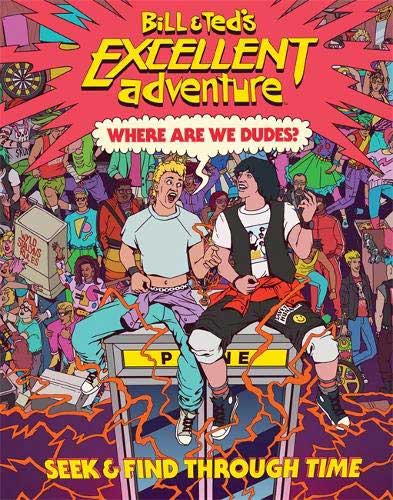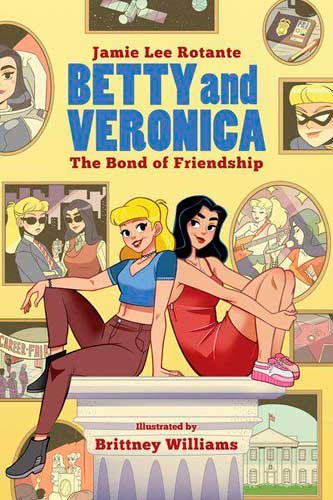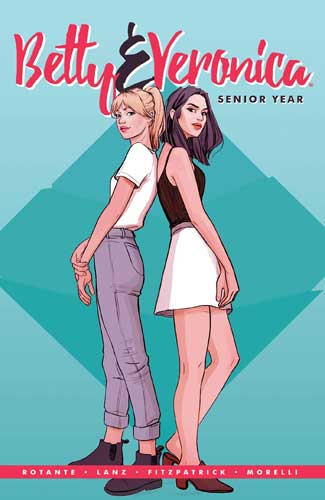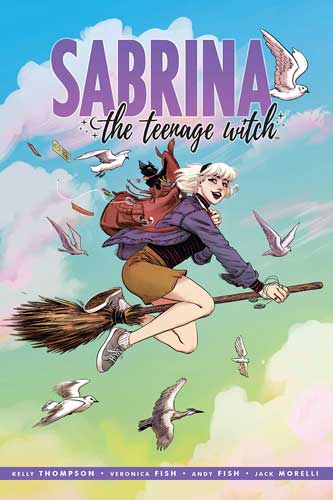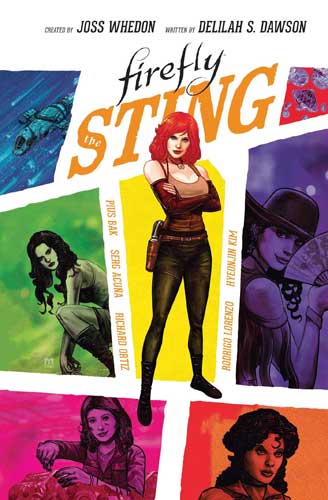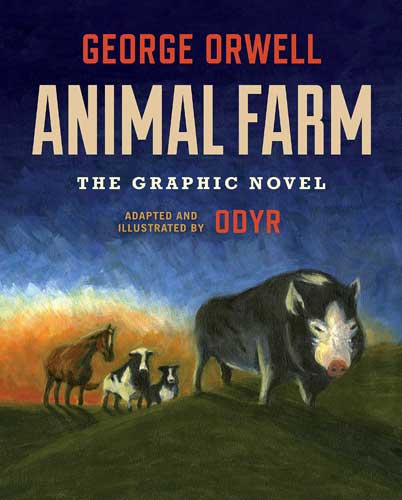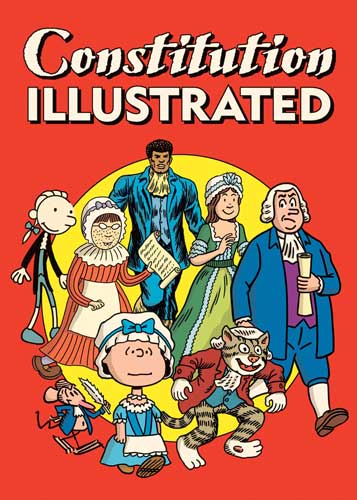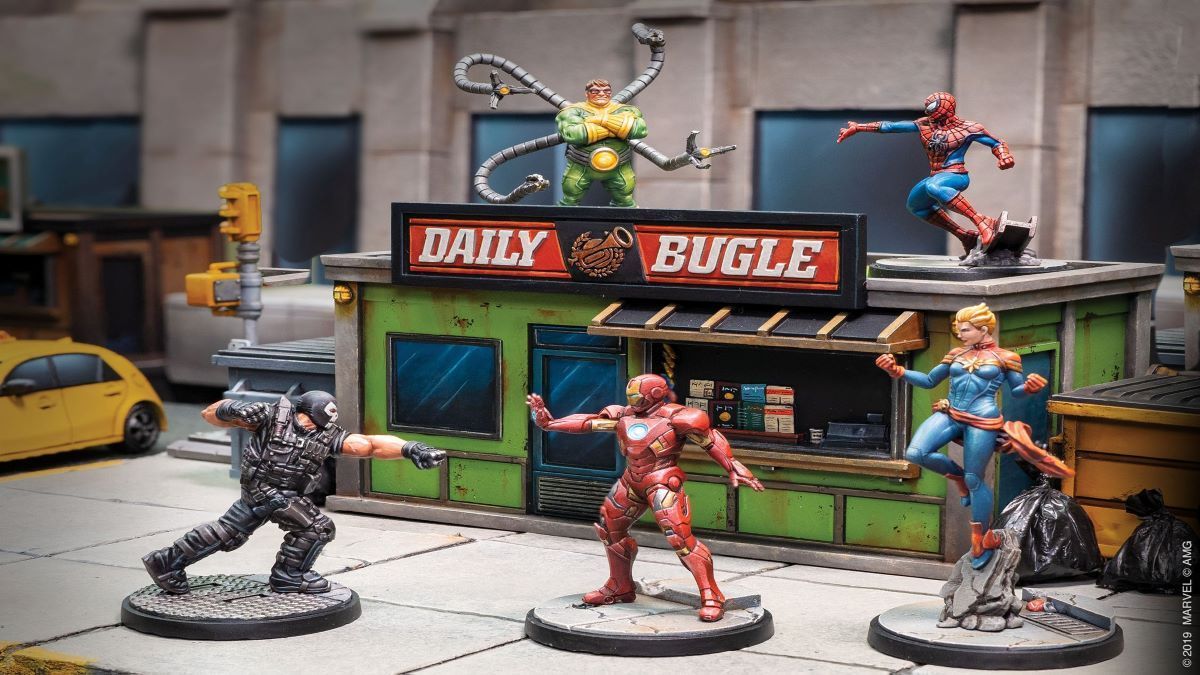Today’s column is a big stack of nostalgia: books (mostly comics) based on television series or movies, or even old comic book series!
Bill & Ted’s Excellent Adventure: Where Are We, Dudes?
This “Seek & Find Through Time” is a bit like a Where’s Waldo? book, but featuring a particular time-traveling duo instead of the stripy, bespectacled guy. The book takes you through various times and locations from the original movie: the wild west, ancient Greece, and even the San Dimas mall. On each page, you look for Bill, Ted, and the phone booth. Rufus is there on each page, too, holding a letter—unscramble the letters for a special message! You’ll also see the various historical figures as Bill and Ted collect them: Billy the Kid in Ancient Greece, Socrates in medieval England, and so on. It’s made to look like a kids’ picture book, but the real audience is probably adult fans of the original film. It’s not a very long book and the images aren’t as jam-packed as Where’s Waldo?, but it has a lot of entertaining details nonetheless.
Bill & Ted’s Excellent Adventure: The Guide to a Bodacious Life
This book looks like the sort of movie tie-in product that could have been published back when the movies were released: little bits of trivia and advice based on the movie like “Five Things You Should Know About Time Travel” and “How to Speak Like Bill and Ted.” There are images from the first two films scattered throughout the book, along with plenty of ’90s-era color palettes and decorations. It’s cute, and may be the sort of thing that could be a fun gift for a Bill & Ted fan, but there’s also not much substance to it, either. I think the seek-and-find book was a little more entertaining.
Betty and Veronica: The Bond of Friendship written by Jamie Lee Rotante, illustrated by Brittney Williams
I used to reach Archie comics occasionally when I was a kid, but I’d mostly lost track of it since then (other than the Jughead time travel comics I read earlier this year). I did watch a bit of the Riverdale series on Netflix and enjoyed it, but it was quite a bit darker and grown-up than the comics. So when I was sent a couple of Betty and Veronica comics, I was curious what they’d be like.
The Bond of Friendship is set at a career fair, and the two friends are exploring different careers to see what might spark their interests. For each career, we hear from a character in the industry, and then there’s a section imagining Betty and Veronica in that career as adults. They become co-presidents of the United States, astronauts, actors, and even superheroes. There’s a lot of humor in the stories, but the book also manages to touch on serious subjects, too. Although the adults they hear from are fictional, I like the way that the book depicts women succeeding in these various fields. Betty and Veronica both learn a bit more about themselves through their imagined careers. A side plot involves their friend Kevin Keller trying to figure out how to tell his dad that he doesn’t want to join the military.
In the comics I’d read as a kid, I felt like Betty and Veronica were mostly rivals, competing for Archie’s affections, so it was interesting to read a story that focused on them and their friendship instead. Archie does make some appearances, but he seems more like comic relief than a love interest in this particular book. It also took me a little bit to get used to the illustration style, which isn’t the classic Archie look; it’s still cartoony but feels a bit more modern.
Betty & Veronica: Senior Year written by Jamie Lee Rotante, illustrated by Sandra Lanz
Here’s another book about Betty and Veronica, this time as high school seniors. Apparently, despite the countless stories about the pair, they’ve never been high school seniors before in the comic books. This book is a bit more realistic than The Bond of Friendship, both in the storyline and the illustration style, with a bit more conflict between the two. There are decisions about where to go to college, and each of them is pulled in different directions: Betty’s family wants her to go to Pickens because she has a scholarship and they can’t afford much else, but Veronica’s family wants her to attend Hitchens University like they did. There are also boy troubles—though these don’t really involve Archie for once—and some tension based on miscommunication. There’s definitely a lot of pressure on Betty and Veronica, and a lot of stress on their friendship, but they do manage to work out a happy ending.
Although I might not specifically seek out more Betty and Veronica books to read, it was fun to check back in on the Archie-verse and see that it’s still going strong, but with a more contemporary feel.
Sabrina the Teenage Witch written by Kelly Thompson, illustrated by Veronica Fish and Andy Fish
Here’s another one from the Archie-verse, though I have even less experience with it. Sabrina is a “half-witch” who lives with her two witch aunts and Salem, a cat who used to be a warlock and can still talk. The storyline in this book involves Sabrina attending a new school, while also coming to terms with her magical abilities. She’s made some promise to herself not to let her magic get out of control, but still finds herself casting spells (in the form of rhymes) throughout the day as she runs into problems, some big and some small. Those problems are a mix of the normal—bullies, love interests, high school social structures—and the supernatural, like the strange beasts that keep appearing in town and attacking her. It was a fun read; the mix of high school drama and an otherworldly mystery reminded me a little of Buffy the Vampire Slayer, in a good way. I can’t really say how the story compares to the old comics (or the TV shows, old or new), but it was a fine introduction to the character even without any prior knowledge.
Buffy the Vampire Slayer – Volume One: High School Is Hell written by Jordie Bellaire, illustrated by Dan Mora
Speaking of Buffy the Vampire Slayer, this is the first volume in a comic book series (from last year) that appears to reboot the series. I’d watched the show back in the day, and had read some of the comics that served as the eighth “season,” but this is another series that I didn’t keep up with after that, so I was surprised to see a “volume one” comic book. Again, Buffy Summers is new to town, starting at Sunnydale High and meeting some familiar (to us) faces like Willow and Xander and Giles … but things aren’t quite the same. For one, Buffy’s mom has a boyfriend, Willow has a girlfriend, and Cordelia seems to be … friendly? And we also run into Spike, Drusilla, and Anya, who are all up to various types of no good.
It’s a curious book, that takes the characters we know and puts them into a bit of a blender, throwing a bunch of them in right from the start. The characters are drawn to look like the actors in the TV series, too, so that makes the reboot idea a little fuzzier. I’d guess that the book is intended more for people who already know Buffy, because otherwise the introduction of some of the characters might not have quite the same impact, but at the same time it’s not the Buffy you already know, either. Perhaps it might be best classified as a remix. Either way, it’s a fun adventure—just not what I had anticipated.
Angel – Volume One: Being Human written by Bryan Edward Hill, illustrated by Gleb Melnikov
Like the Buffy book above, this is the start of another remix, this time of the Buffy spin-off Angel, featuring the tormented vampire-with-a-soul who (at least in the original series) ends up being Buffy’s boyfriend. The storyline in this book jumps back and forth between the present day and the past. In the present, we see Angel leaving Los Angeles after losing (another?) trainee and moving to Sunnydale; in the past, we get glimpses of Angel’s violent history. The modern story involves a being that is preying on kids through social media; in the course of the story, Angel meets Winifred (known as Fred on the TV show), and we get a foreshadowing about Gunn as well.
It’s interesting to see these remixes; the characters have been defined well enough through the shows that they can be thrown into new stories and new configurations and still feel like themselves, similar to superhero comics like Superman, for instance. It does wreak some havoc on the idea of canon and continuity, though, but perhaps primarily because I still think of them as a once-and-done TV series with a defined story arc. I’m used to seeing stories that could have taken place in between the episodes, but not stories that take place in an entirely different possible world.
Firefly: The Sting written by Delilah S. Dawson, illustrated by Pius Bak, Serg Acuña, Richard Ortiz, Hyeonjin Kim, Rodrigo Lorenzo
The story in Firefly: The Sting is one that could have taken place sometime during the TV series (though I admit I don’t know the series well enough to tell you exactly where). The crew lands on the planet Carolan and the ship is immediately impounded, so Mal has to get a job done to pay the fee. But the story’s not about that job. Instead, it follows the women as they head off with Inara for a spa day that turns out to be a lot less relaxing than they’d expected. It turns out that Saffron stowed away with them, and blackmails them into pulling a job with her. It involves sneaking into a convent on the evening of initiation, which involves a huge party where rules are overlooked, but Saffron has a lot of tricks up her sleeves. Firefly is a series that ended too soon, so it was fun to read a book that basically serves as an additional episode.
Child Star by Box Brown
Owen Eugene, the star of Child Star, didn’t actually exist, nor did the hit sitcom Everybody’s Friend, nor did his catchphrase “I don’t understand!” But despite that, this graphic novel will still seem familiar to anyone who grew up watching TV in the ’80s and followed the stories about child actors. Owen has a medical condition that made him small for his age, which made him seem precocious. He got jobs in commercials, and then became the star of a TV series, along a few movies, and became the highest-paid actor in television. The book is told through “interviews” with various people close to Owen: his parents, other actors, producers, and so on. Interspersed throughout the interviews are “clips” from shows and movies.
The character (and the shows he appears in) are an amalgamation of child stars: there’s an episode of Everybody’s Friend, when they decide to tackle serious issues, where Owen’s character gets trapped in an old refrigerator during a game of hide-and-seek, a plotline I remember from Punky Brewster. Owen had a falling out with his parents over his finances, and that’s also a familiar conflict, where the parents did what they thought was appropriate while they were in charge of the money, but then the actor discovers there’s not much left by the time he reaches adulthood. He’s often older than the kids who star with him, which makes those relationships difficult, and his character is always less mature than he is. It’s a sad story, punctuated with moments of humor (particularly in the show clips, many of which are exactly the sort of thing I grew up watching but seem inane now).
Box Brown has written a few non-fiction comics, like his biographies of Andre the Giant and Andy Kaufman, or his book about Tetris. This is the first of his books I’ve read that was fictional, but it reads a lot like the others: it’s the comic book equivalent of a documentary, though imaginary. It’s a remarkable story, and it made me think a bit about the lives of actual Hollywood kids and the struggles they go through for our entertainment.
Animal Farm: The Graphic Novel written by George Orwell, adapted and illustrated by Odyr
Animal Farm is one of those books that was regularly on reading lists when I was in school, though I don’t know if it’s still assigned reading these days. It probably should be, though: the lessons in the book are still just as relevant today as they were when they were written—though maybe kids don’t necessarily need a sobering fable with a tragic ending to remind them of the dangers of corruption.
In Animal Farm (in case you missed it somehow), the animals are sick of the fact that they do all the work and the farmer profits from their labor, so they rally together and kick him out, and run the farm for themselves. It takes a lot of work to get things working, but they have hope for the time when they reap the benefits for themselves. The pigs, however, are the cleverest ones, and they manipulate the other animals, taking the best for themselves and rewriting the rules when it’s convenient. Poor old Boxer the horse, believing their promises, supports them all the way to the end despite the fact that they clearly don’t have his best interests at heart. Animal Farm reminds us that even movements that begin with good reasons can become corrupted, and that often the majority suffers the same no matter who is in power.
This graphic novel features illustrations that really bring the story to life. The paintings are expressive and somewhat rough: you can see the brushstrokes, giving it a bit of an impressionistic look. The story is familiar, yet still shocking. Hopefully we’ll eventually manage to learn its lesson.
Constitution Illustrated by R. Sikoryak
We’ll end with a book based on a really old piece of writing: the Constitution of the United States. This book takes the text of the Constitution and pairs it with illustrations based on a variety of comics, from superhero comic books to comic strips to television cartoons. R. Sikoryak adds powdered wigs and period costumes to the characters. Sometimes the illustration matches the text, as when Luke Cage breaks his chains in the section about the 13th Amendment abolishing slavery, or Scrooge McDuck with his pile of gold in Section 8 about Congress’ power of taxation. The book draws from a very wide range of sources: the Yellow Kid, Beetle Bailey, Steven Universe, The Simpsons, and more all appear in these pages.
But Sikoryak does not offer much in the way of commentary: it’s simply the text of the Constitution, reproduced as captions and speech bubbles. If he has an opinion or thoughts about the text, he keeps them to himself (unless you can draw any conclusions about specific illustrations paired with certain sections). It’s an intriguing experiment, but it may not be something you’d pick up to read straight through—I found myself just paging through it first to look at all of the images, just skimming to see what section was covered at the time.
Sikoryak previously tackled iTunes Terms and Conditions in the same way, casting various cartoon characters as Steve Jobs; that one had the disadvantage of being significantly longer and changing even while he was working on the book. From what I could see, his ability to emulate different artists has improved since then, too; if it weren’t for the costume changes, there are many pages that look like they came straight from the source comics.
It may not be a book I read straight through for pleasure, but it’s still a fun format to have as a reference.
Disclosure: I received review copies of these books. Affiliate links to Bookshop will earn a commission for me, as well as supporting independent bookstores.
My Current Stack
Aside from the comics above, I’ve been making my way through Andrew Bannister’s Spin trilogy. I’d read Creation Machine a while back but then misplaced the second book. I’ve now finished Iron Gods and have started Stone Clock, so expect to see more about those in the coming weeks. I’ve continued reading the Dystopia Triptych by John Joseph Adams and am about halfway through each of the books. (Each author contributed one story per volume, so I’ve been reading them in series.) I’ll have more to say about these later, but they’re quite good—though because of the subject matter, it can be hard to read a bunch of them at a time. Finally, I finished How to Argue With a Racist by Adam Rutherford. It’s about genetics and where they do and don’t matter, and how that plays into the way we talk about race and our differences. Stay tuned for more about that one, too.

